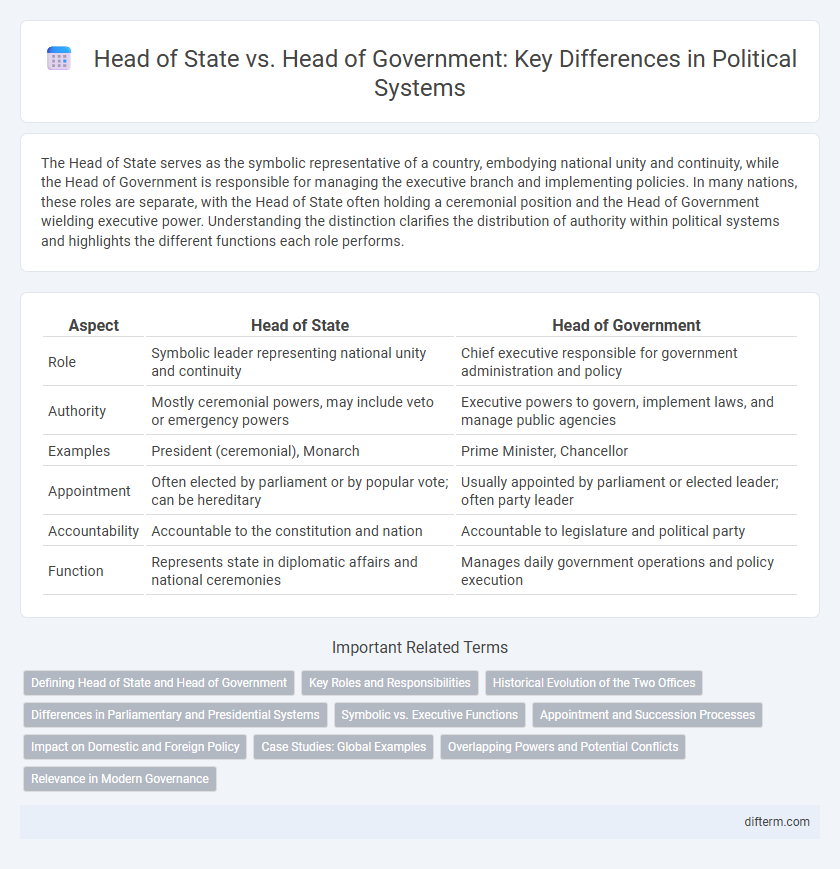The Head of State serves as the symbolic representative of a country, embodying national unity and continuity, while the Head of Government is responsible for managing the executive branch and implementing policies. In many nations, these roles are separate, with the Head of State often holding a ceremonial position and the Head of Government wielding executive power. Understanding the distinction clarifies the distribution of authority within political systems and highlights the different functions each role performs.
Table of Comparison
| Aspect | Head of State | Head of Government |
|---|---|---|
| Role | Symbolic leader representing national unity and continuity | Chief executive responsible for government administration and policy |
| Authority | Mostly ceremonial powers, may include veto or emergency powers | Executive powers to govern, implement laws, and manage public agencies |
| Examples | President (ceremonial), Monarch | Prime Minister, Chancellor |
| Appointment | Often elected by parliament or by popular vote; can be hereditary | Usually appointed by parliament or elected leader; often party leader |
| Accountability | Accountable to the constitution and nation | Accountable to legislature and political party |
| Function | Represents state in diplomatic affairs and national ceremonies | Manages daily government operations and policy execution |
Defining Head of State and Head of Government
The Head of State serves as the symbolic representative of a country's unity and legitimacy, often performing ceremonial duties and embodying national identity. The Head of Government manages the executive branch, directing administrative functions and policy implementation, typically holding political power to govern day-to-day affairs. In parliamentary systems, these roles are distinct, while in presidential systems, one individual may fulfill both positions.
Key Roles and Responsibilities
The Head of State acts as the symbolic representative of a country, embodying national unity and often performing ceremonial duties, such as signing legislation and representing the nation in diplomatic affairs. The Head of Government is responsible for running the country's administration, setting domestic policies, and overseeing the executive branch, including managing the cabinet and government agencies. While the Head of State may hold limited political power depending on the system, the Head of Government wields significant authority in policymaking and government operations.
Historical Evolution of the Two Offices
The historical evolution of the Head of State and Head of Government offices reflects distinct constitutional developments separating symbolic representation from executive authority. Traditionally, the Head of State embodied national unity and continuity, often as a monarch or ceremonial president, while the Head of Government emerged as the political leader responsible for policy and administration. Over time, especially in parliamentary systems, this division solidified to balance power, enhance governance efficiency, and adapt to democratic norms.
Differences in Parliamentary and Presidential Systems
In parliamentary systems, the Head of State often serves a ceremonial role while the Head of Government wields executive power, typically as the prime minister. In presidential systems, the President combines both roles as Head of State and Head of Government, holding significant executive authority. This structural distinction shapes the balance of power, political accountability, and the functioning of government institutions.
Symbolic vs. Executive Functions
The Head of State primarily fulfills symbolic functions, representing national unity and serving as a ceremonial figurehead embodying the nation's identity. In contrast, the Head of Government holds executive functions, directing policy-making, administering government operations, and overseeing the implementation of laws. These distinct roles highlight the separation between symbolic representation and practical governance in political systems.
Appointment and Succession Processes
The Head of State is typically appointed through hereditary succession or a formal parliamentary process, often symbolizing national unity and continuity. The Head of Government is usually appointed by the legislature or elected directly, responsible for running the executive branch and implementing policies. Succession for the Head of State follows constitutional or traditional rules, while the Head of Government's succession depends on parliamentary confidence, elections, or party leadership changes.
Impact on Domestic and Foreign Policy
The Head of State primarily shapes a nation's foreign policy by representing the country in international affairs and symbolizing national unity, while the Head of Government drives domestic policy through legislative agendas and administrative functions. In parliamentary systems, the division between these roles allows focused governance, with the Head of Government implementing policies that impact economic development, social programs, and internal security. The dynamic between these positions influences policy coherence, with the Head of State facilitating diplomatic relations and the Head of Government addressing domestic governance complexities.
Case Studies: Global Examples
The distinction between Head of State and Head of Government varies significantly across countries, illustrated by case studies such as the United Kingdom, where the monarch serves as Head of State and the Prime Minister as Head of Government, and Germany, where the President holds a largely ceremonial Head of State role while the Chancellor functions as Head of Government with executive power. In the United States, the President combines both roles, serving as the symbolic Head of State and the chief executive responsible for government operations. These models highlight diverse constitutional frameworks shaping political authority and governance functions globally.
Overlapping Powers and Potential Conflicts
The Head of State often holds ceremonial duties and symbolic authority, while the Head of Government manages executive functions and policy implementation, yet their powers can overlap in constitutional monarchies or parliamentary systems where both participate in legislative processes. Potential conflicts arise when their political agendas diverge, leading to power struggles over appointments, foreign policy decisions, or crisis management. This overlap requires clear constitutional delimitations to maintain balance and prevent governmental deadlock.
Relevance in Modern Governance
The Head of State symbolizes national unity and continuity, often performing ceremonial duties and representing the country in diplomatic affairs. The Head of Government manages day-to-day operations, policy implementation, and executive decision-making, typically leading the cabinet and administration. Understanding their distinct roles is vital for analyzing power distribution and political accountability in modern governance systems.
Head of State vs Head of Government Infographic

 difterm.com
difterm.com